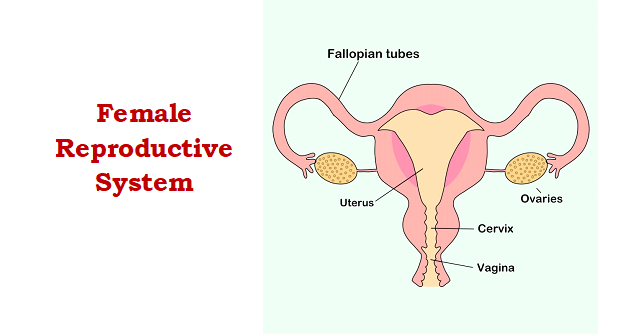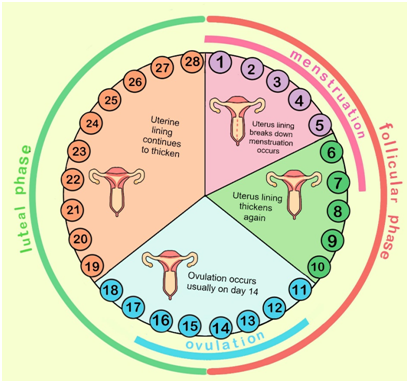
What is menstruation?
Menstruation is a periodic process of shedding the inner lining of the uterus and discharging of it along with blood and other substances. During menstruation, tissue from the inner uterine lining flows down through the cervix and released through the vagina in the form of menstrual fluid. Menstruation normally starts between the ages of 12 and 16 years and continues until late 40s or mid-50s. It typically lasts for 3-7 days every month.
- Occurrence of menstruation for the first time is called Menarche (between 12 and 16 years).
- End of menstrual cycle is marked as menopause (Continuous 12 months without menstrual cycle in late 40s or mid-50s).

Menses and Periods are synonyms used for Menstruation
Why do girls and women have periods?
When an egg released from the ovaries do not fertilize and/or attach itself to the uterine wall, the lining of the uterus sheds itself and menstruation starts.

Menstruation is not same as menstrual cycle. Menstruation is one of the four phases of the menstrual cycle.
What is a Menstrual cycle?
Menstrual cycle is a series of changes in the female body under hormone influences, which lasts from the first day of the period until the first day of next period. It normally ranges from 28-35 days and varies from woman to woman.
In each menstrual cycle, an egg develops and releases from the ovaries. The uterus develops a lining intended to protect the fertilized egg. However, if the egg is not fertilized or when no pregnancy occurs, the uterus lining sheds itself out along with remnants of the egg, mucus and blood.

Phases of menstruation cycle
A monthly menstrual cycle comprises of four phases, which are explained below.
Menstruation phase:In this phase uterus lining shed and discharge through the vagina along with blood known as the menstrual period. It starts on the first day of menstruation and represents one of the four weeks of menstrual cycle.
Follicular Phase: In this phase follicles containing the immature egg grows and the uterus lining starts getting thicker. This phase overlaps with the menstrual phase and starts with the first day of period and ends when ovulation phase starts. Follicular phase normally lasts for about 14-16 days.
Ovulation phase: In this phase, mature follicle ruptures and releases the egg into the fallopian tubes, to be fertilized by a sperm. Ovulation usually occurs in the middle of the menstrual cycle (at around day 14). The ovulation phase is the only time when females can get pregnant.
Luteal Phase: The last two weeks of the cycle is called luteal phase. It occurs after ovulation and in this phase uterus lining gets thicker to prepare for possible pregnancy.

Phases of menstruation cycle
What are the normal features of
Duration of menstruation flow - Normally lasts for 3-7 days. Exact duration varies from woman and woman.
Amount of blood loss - Amount of blood loss during periods ranges from 10 to 80 millilitres, with an average of 35 millilitres. Usually measured with number of pads/absorbents used.
Flow pattern - Menstrual flow is usually high in initial days and starts diminishing towards the end of the menstrual phase.
- Menstruation is a natural process. It happens with every girl and women.
- Periods in first few years may not be very regular
- Majority of girls attain menarche between 12 and 16 years, however, a few have it before and after that age
- Menstrual cycle usually occurs in every 28-35 days, while some may have longer or shorter cycle
- Abdominal pain during initial days of periods is normal
What is Premenstrual syndrome?
Before or at onset of menstruation, a female may experience some physical or psychological symptoms or events due to changes in hormones. These symptoms or events are called premenstrual syndrome (PMS).
How to deal with premenstrual syndrome?
Premenstrual symptoms are normal about a week or two before periods. These symptoms vary from women to women. For some women these symptoms may be so severe that make them unable to perform daily/routine activities, while for others, these symptoms are mild.

Following tips may help in relieving some of the PMS symptoms.

What are the signs of an abnormal menstrual cycle?
Menstrual cycle that occurs in much longer or shorter duration; irregular (skipping of 3 or more periods in a row); unusually heavy or light flow and with severe pain during menstruation can be defined as abnormal cycle. Abnormal menstrual cycle could be a sign of endometriosis, polycystic ovary syndrome (PCOS), fibroids or a bleeding disorder.
Be familiar with your menstrual cycle including duration of menstrual flow, quality of blood, amount of blood loss etc.
Warning Signs
Shorter menstrual cycle
Occurrence of menstrual periods in less than every 21 days.

Longer menstrual cycle
Occurrence of menstrual periods in more than every 35 days.

Skipped periods
Markedly irregular periods after happening regularly every month.
Abnormally long periods
Menstrual periods that last for more than seven days.

Menstrual periods requiring frequent absorbent changes (more than once every one or two hours).


Menstrual periods accompanied with severe abdominal pain, cramps, nausea etc.
What causes abnormal menstrual cycle?
Many factors ranging from serious underlying medical conditions to lifestyle habits causes abnormal menstrual cycle.
• Gaining or losing significant weight
• Changes in exercise routine
• Food habits
• Stress
• Illness
• Uterine cancer or cervical cancer
• Under or overactive thyroid gland
• Other medical conditions
such as endometriosis, PCOS,
fibroids, pelvic inflammatory disease etc.
Understanding Menstruation
